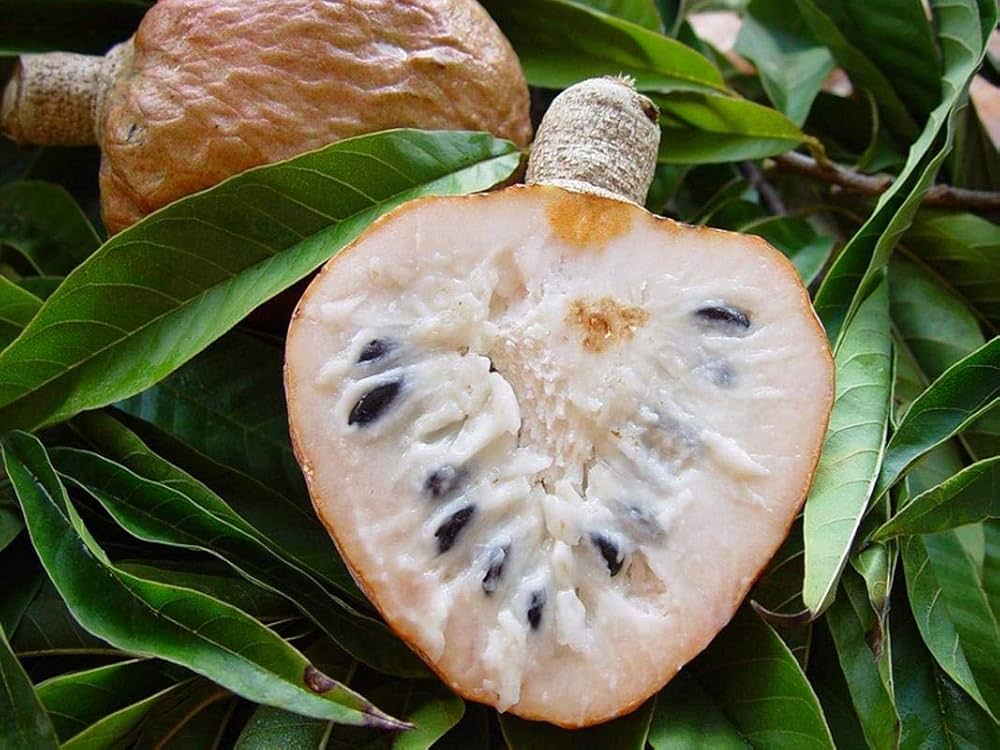Love it? Add to your wishlist
Your favorites, all in one place. Shop quickly and easily with the wishlist feature!
[message]
[title]
[message]

Veliyath Gardens
Couldn't load pickup availability
Custard Apple Fruit Plant (Annona Reticulata): A Sweet and Nutritious Delight
The Custard Apple (Annona reticulata), also known by a variety of names including Ramphal, Bullock’s Heart, and Sugar Apple, is an exotic tropical fruit plant that holds both culinary and medicinal value. With its fast-growing nature and delicious fruit, it has become a favorite in home gardens and orchards worldwide. At Veliyath Gardens, we are proud to highlight the Custard Apple as one of the valuable additions to your plant collection.
Botanical and Common Names
An Overview of the Custard Apple Tree
The Custard Apple tree is a fast-growing, small deciduous or semi-evergreen tree that produces one of the most unique tropical fruits known for its smooth, creamy texture. Unlike other varieties in the Annona family, the Custard Apple fruit has a smooth skin that turns a dull red when ripe. Its flesh is sweet, sugary, and custard-like, though it is often less flavorful than its close relatives, like the Sugar Apple (Annona squamosa).
The Custard Apple tree is particularly popular in tropical regions for its ability to bear fruit quickly, usually within 2 to 3 years of planting. The fruit is typically eaten fresh but also has culinary uses, particularly in enhancing the flavor of ice cream and other sweet treats. Its distinct taste and texture make it a sought-after fruit for many people around the world.
Nutritional Benefits
The Custard Apple is a rich source of nutrition, making it a valuable fruit for health-conscious individuals. It is an excellent source of carbohydrates, dietary fiber, and essential vitamins and minerals. The fruit is known for its high content of:
Along with its rich vitamin and mineral content, Custard Apple is low in fat and cholesterol, making it a healthy choice for those seeking a nutritious and low-calorie fruit. The sugars present in the fruit are natural and offer a quick energy source.
Health Benefits and Medicinal Uses
The Custard Apple is highly regarded in traditional medicine for its wide range of health benefits. Its leaves, seeds, and fruit have all been utilized in various cultures for treating a variety of ailments. The fruit itself is known for:
Due to its calming properties, the Custard Apple is often used as a remedy for fever, making it a valuable fruit in regions where such conditions are common.
Cultural Significance
The Custard Apple has significant cultural importance in various regions of the world, especially in South Asia, Africa, and Latin America. In many communities, it is considered a symbol of prosperity and is often included in celebratory meals and festivals. Its sweet, creamy pulp is used to flavor traditional sweets and beverages, making it a favored ingredient in desserts.
In tropical areas, Custard Apple is a symbol of the abundance of nature and is often grown in home gardens for its practical uses as both a food and medicinal plant. In India, the Custard Apple is widely known as "Ramphal" and is commonly enjoyed in the summer months.
Environmental Impact and Sustainability
The Custard Apple tree thrives in warm, tropical, and subtropical climates, making it a suitable addition to gardens in regions that experience mild winters. Its fast-growing nature and moderate maintenance needs make it an easy plant to cultivate. The tree’s ability to adapt to various soil types and climates means that it can be planted in diverse environments, contributing to biodiversity in both rural and urban landscapes.
By growing a Custard Apple tree, you are also supporting the local ecosystem, as the tree provides shelter for various pollinators and wildlife. It is an eco-friendly choice for gardeners who wish to support their environment while enjoying a delicious fruit.
The tree’s resilience to pests and diseases adds to its sustainability, requiring minimal chemical intervention. The leaves of the Custard Apple tree also contribute to organic matter in the soil, helping improve soil fertility and supporting the surrounding plant life.
Cultivation and Maintenance
The Custard Apple tree is known for its relatively low maintenance requirements, making it an ideal choice for home gardeners and commercial growers alike. Here are the key details regarding its cultivation:
Conclusion: Why Grow the Custard Apple Tree?
The Custard Apple tree is a fantastic choice for those looking to add a tropical touch to their garden while reaping the benefits of its nutritious, sweet fruit. Its quick-growing nature, coupled with its health benefits, makes it an ideal plant for both novice and experienced gardeners.
Whether you are growing it for its delicious custard-like pulp, its potential health benefits, or its role in supporting the environment, the Custard Apple tree is a versatile and rewarding plant. Its low maintenance and quick fruiting make it an excellent addition to your garden, while its cultural and medicinal significance enhances its value.
At Veliyath Gardens, we invite you to explore the many benefits of the Custard Apple tree. With its unique flavor, quick growth, and various health benefits, it is a delightful and valuable fruit tree for any garden.
Maintenance Level: Moderate
Blooming & Fruiting Time: 2 to 3 years
Ideal for: Tropical and subtropical climates
A Sweet and Nutritious Addition to Your Garden – Add the Custard Apple Today!
Its fast-growing nature and moderate maintenance needs make it an easy plant to cultivate. The tree’s ability to adapt to various soil types and climates means that it can be planted in diverse environments.
The Custard Apple is a rich source of nutrition, making it a valuable fruit for health-conscious individuals. It is an excellent source of carbohydrates, dietary fiber, and essential vitamins and minerals.
Vitamin C: Boosts immunity, promotes skin health, and acts as a potent antioxidant.
Potassium: Helps regulate blood pressure and supports heart health.
The fruit is typically eaten fresh but also has culinary uses, particularly in enhancing the flavor of ice cream and other sweet treats.


